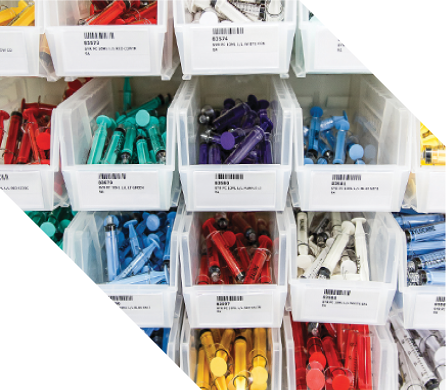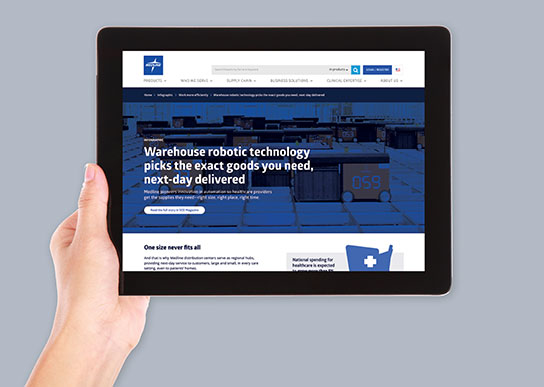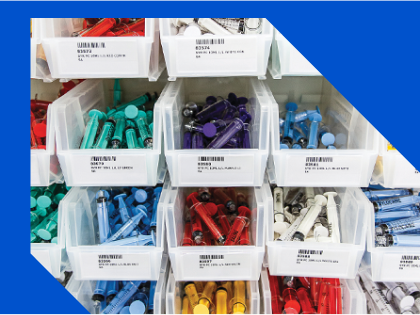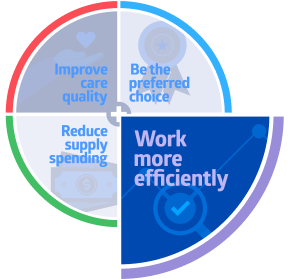
Insight
As health systems look for every possible way to save, product pricing is a common target. But beyond hard costs, there are soft cost opportunities that can have just as big an impact on the bottom line. Freeing up clinicians from performing nonclinical tasks is a primary one.
Caregivers spend a lot of time hunting down items, putting away supplies and filling out paperwork. In fact, studies show they can spend almost ten hours per shift managing supplies and only two hours caring for patients.1
We helped a nationally renowned academic medical center implement two low-tech supply management processes: enhanced LUM and 2-bin replenishment. Now nurses spend more time caring for patients than managing supplies.
Organization
Leading academic medical center
This Northeast IDN consists of five hospitals, including its flagship facility which is designated as a Level One regional trauma and burn center. It also has six urgent care centers and an extensive primary care network. The system has over 26,000 employees.
Challenges
- Manual supply maintenance decreased time with patients
- Too many touchpoints in supply delivery process
- Inefficient process for tracking expired products
Actions
- Streamline supply processes
- Establish real-time stock visibility
- Introduce a two-bin replenishment system
- Implement an enhanced LUM program
Results
- Centralized supply chain processes at two hospitals within 3.5 years
- Reduced expired product check from 28 to one hour per month
- Decreased dock-to-stock time by 50% at no additional labor cost
Challenges
The IDN’s supply chain leadership realized their clinical and materials management staff were spending too much time on supply delivery logistics and inventory management. As caregivers spent more time searching for medical supplies, patient care and clinician satisfaction decreased.
“A hospital’s supply chain needs to provide the right product at the right time to the right clinician,” explained the IDN’s Associate Vice President of Purchasing and Supply Chain. “We recognized that by enhancing a few time-consuming processes, clinicians would be able to focus more on patient care.”
Strategic partnership
It was clear to leadership that they needed to address these challenges in the near term, while making a fundamental shift in their long-term supply chain design. They wanted a single strategic partner whose distribution expertise would help them achieve a best-in-class supply chain. They chose Medline.
“When I joined, I realized having an integrated partner to consult is key. Medline has a single point of contact we can count on to identify and implement supply chain optimization efforts,” noted the IDN’s Associate Vice President.
Actions
To achieve the IDN’s goals for operational efficiency, we implemented several supply chain optimization solutions. These included:
- Put-Away-Ready, an advanced LUM program that eliminates touchpoints by delivering supplies unpacked and pre-organized where needed in each facility, and
- SmartBin, two-bin automated replenishment technology that streamlines inventory management.
Results
Since beginning their partnership with Medline, this Northeast IDN has:
- Centralized supply chain processes at two hospitals
- Rolled out Put-Away-Ready at two brand new facilities, reducing dock-to-stock time by 50% at no additional labor cost
- Implemented SmartBin across 14 supply rooms in one of the hospitals, decreasing the time spent checking for expired products from 28 hours to just one hour per month
These products and solutions helped streamline the IDN’s supply chain, removing unnecessary steps and freeing staff to focus on direct patient care.
References:
1.Collins, R. Bring Nurses Back to the Bedside. For the Record. 2015;27(9):10. Available at: https://www.fortherecordmag.com/archives/0915p10.shtml. Accessed March 2, 2020.
Please complete the form to receive additional content when published.



